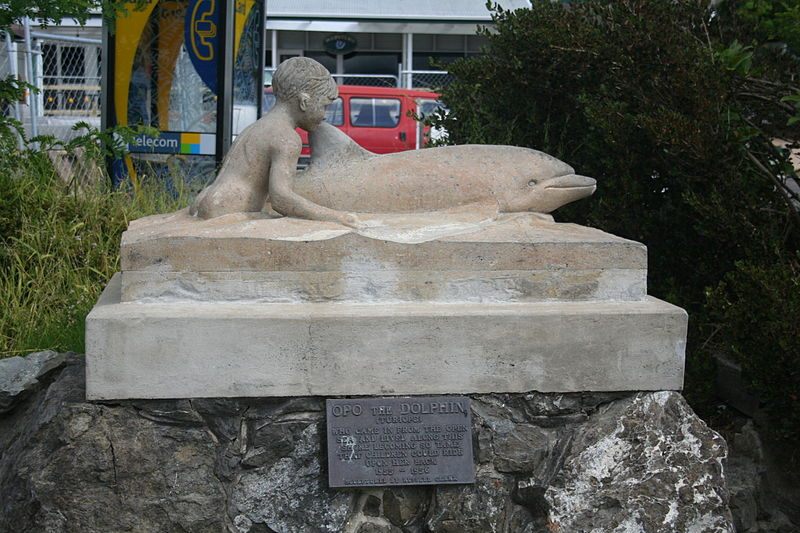The Brief, Bright Life of New Zealand’s Beloved Celebrity Dolphin
In the summer of 1955, the friendly Opo charmed beachgoers with tricks and devotion.

Opononi is a tiny New Zealand fishing town nestled just inside the mouth of the Hokianga Harbour, in the country’s Northland Region. With a permanent population of fewer than 500 people, it’s hardly Daytona Beach, but during the southern-hemisphere summer of 1955-56, Opononi attracted thousands of visitors from across the country. They came because they wanted to catch a glimpse of a visitor who’d appeared on the beach: a playful dolphin who came to be known as Opo.
Opo the Gay Dolphin (gay as in happily excited, nothing to do with sexual orientation) was a lone female bottlenose dolphin who began frequenting the Opononi beach around June of 1955. The fishermen found that she liked being scratched and rubbed with an oar or deck mop, in between rolling around under their boats. As the fishermen became more comfortable interacting with the dolphin, she in turn seemed to seek them out more regularly. Soon, she would almost always come swimming at the sound of an outboard motor.
The dolphin eventually started following familiar boats as they returned home, drawing her closer to shore, and soon she was interacting with local beach-goers almost daily. At first the locals gave her the nickname “Opononi Jack,” as a reference to another famous New Zealand dolphin, Pelorus Jack, who’d became famous around the turn-of-the-century for supposedly guiding boats through the treacherous waters of the Cook Strait. However, since the Opononi visitor was female, the nickname eventually got truncated down to Opo.
Opo began visiting the beach daily throughout the summer of 1955, and seemed to especially like interacting with children. The dolphin would swim around kids, and even allow some of them to be pulled along through the water on her back. Opo formed a particularly strong bond with a young girl named Jill Baker. When Baker, who swam almost every day, entered the water, Opo would usually dart over to her to play, sometimes swimming under her legs and picking her up for a short ride.
As the crowds continued to grow on the small beach, Opo’s arsenal of tricks grew as well. The creature became known for playing with a beach ball, bouncing it off her nose, or rolling it down her belly and balancing it on her chin. Opo also got used to performing similar tricks with a beer bottle.
During the months that Opo was a recurring attraction at Opononi beach, she never bit or otherwise injured anyone—no small feat considering the pokes, prods, and manhandling she no doubt endured. Stories of Opo hit the national newspapers and beyond, attracting thousands of curious visitors to the tiny town. The nearby roads were often crammed with cars stuck in traffic trying to get to the beach. By the beginning of 1956, Opo fever was in full swing.
Eventually, locals began taking measures to try to keep her safe. The Opononi Gay Dolphin Protection Committee organized the installation of a sign that read, “Don’t Try to Shoot Our Gay Dolphin,” possibly another reference to Pelorus Jack, who was once shot at by some sailors. But in the end, such efforts tragically proved to be too little, too late.
In early 1956, the Protection Committee successfully lobbied the government council to create a new law protecting dolphins in the Hokianga Harbour. This new regulation, which made it illegal to “take or molest” dolphins in the harbor, carried a fine of £50, and went into effect at midnight on March 8. On March 9, Opo was found dead among some sharp rocks.

The exact cause of Opo’s death quickly became a matter of debate. Some suggested that she had become confused while hunting some fish and ended up among the sharp rocks, while another popular theory was that she had been scared into the rocks by some fishermen using explosives. Either way, Opononi’s gay dolphin days were at an end.
People throughout the country observed the beloved dolphin’s passing. In Opononi, businesses were shuttered for a day of mourning. A hockey team on the other side of the island wore black armbands during one of its games. Letters and condolences poured into the town from across the country. Opo was ceremoniously buried in a flower-covered grave next to the local veterans’ hall.
While Opo did not live to see the law or legacy she inspired, the gay dolphin is still well-remembered among New Zealanders. There is a stone monument to Opo in Opononi, and her story has been immortalized in songs and children’s books. As one of the songs about Opo (hastily and inaccurately written just before, and released just after, her death) says,
There never was such a dolphin
in the whole of the Tasman Sea
Across the waves he likes to shoot
you never saw a fish that looked so cute















Follow us on Twitter to get the latest on the world's hidden wonders.
Like us on Facebook to get the latest on the world's hidden wonders.
Follow us on Twitter Like us on Facebook